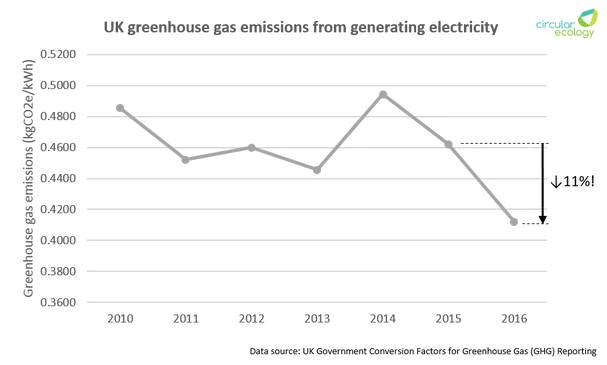Carbon Footprint, Energy, News
Defra 2016 Emissions Factors Released
The UK government has released the 2016 conversion factors for calculating your greenhouse gas emissions. They are co-produced by the environment department, Defra.
The factors cover emissions from key activities, including the use of energy, water, transport and materials, as well as the production of waste.
Read on to find a summary from Circular Ecology’s Dr Stephen Allen of what’s new this year.
What’s New?
The most important change for most organisations will be the large drop in emissions from the electricity you use.
This is thanks to a significant decrease in coal generation, and an increase in gas and renewables generation in 2014 (the inventory year for which the 2016 GHG Conversion Factor was derived). As shown in the figure below, the generation of an average kWh in 2016 produced 0.41205 kgCO2e of greenhouse gas emissions, 11% less than 2015.
This means that, all other things being equal, the carbon footprint of your electricity use will drop by 11% between 2015 and 2016. The good news is that this follows a general trend of reducing electricity emissions, as the figure shows. However, changes between individual years can sometimes work the other way – there was an 11% increase in emissions between 2013 and 2014. Reducing the amount of electricity you use is therefore also an important part of reducing your carbon footprint, and generally essential for getting emissions down to the levels needed to limit climate change.
Other Updates
Other changes this year are that factors for countries outside the UK are no longer included. Users need these if they have operations using electricity overseas. Now, it is referring users directly to the underlying source at the International Energy Agency.
Relative to recent years, the government says that only a small number of methodology changes have been made this year, as a result of ongoing quality assurance. There has been a change to the method of calculating of electricity emissions factors, but it states that this change is insignificant and hence there is no re-issue of historic emissions factors. This is good news in the sense that you don’t need to recalculate past emissions!
To access the 2016 Defra emissions factors, click here.
Need Help?
Calculating an accurate and meaningful trend in your greenhouse gas emissions is essential for effective carbon and environmental management.
If you need any help in using emissions factors, please feel free to get in touch or join one of our training courses on carbon footprinting.
If you like this news item please do share it on social media, using the buttons below, or sign up to our newsletter.


